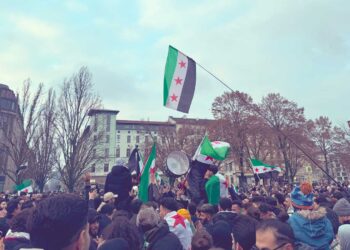Urban riots are not a French specific phenomenon. They occur frequently in so-called liberal democratic countries. In recent years one of the most relevant movements that has emerged from urban rage is the Black Lives Matter movement, after the 2014 killing of Michael Brown by the police in Missouri, triggering the Ferguson protests lasting over 3 weeks[1].
Similar events have also recently occurred in Stockholm and Athens.
In France, however, riots have a multi-dimensional character, and they are not limited only to racial discrimination but are strictly related to the political and historical roots of the French republican system.
The regular recurrence of riots since the 1980s, as Dikeç (2017) points out, shows that the progressive erosion of the welfare state has exacerbated inequalities and forms of exclusion in social, economic, and also in political terms.
Political inequality in particular stems from the marginalization of voices belonging to specific groups, such as migrants from old French colonies. The country’s colonial past, therefore, plays a critical role in framing the current inequalities, as the State has tried to govern its citizens in a unique melting pot, without recognizing their different ethnic and religious belonging.
The feeling of social exclusion
After Mitterrand’s rise to power in 1980s, the transition to a neoliberal economic system accelerated, as social and educational services were cut, despite Mitterrand’s socialist programme.
These trends did not change during the socialist governments of Jospin (1997-2002) and Hollande (2012-2017). One of the main consequences was the increase in inequalities and poverty, which affected mainly low-income areas such as the banlieues.
During the 1960s, these areas were actually inhabited by middle class families and individuals: teachers, civil servants, nurses, and so on. During the Trente Glorieuses[2] (the three decades of economic growth following the Second World War), these groups left gradually the banlieues and the Grands Ensembles[3](large scale Housing Estates) and moved to suburban areas with independent houses.
The banlieues of the Grands Ensembles rapidly became areas of poverty and social exclusion, and they were populated in majority by people of migrant origin.
According to a study of INSEE, in 2008, 25% of African immigrants and 30% of Turkish immigrants were living in banlieues classified as ZUS (Sensitive Urban Areas) compared to only 4% of native French and 5% of immigrants from other European countries[4].
The concentration of poverty in these areas caused increased criminal activities, especially drug dealing and violence, and the perpetrators are often identified as being of the ethnic origin of the inhabitants (mostly from North African or French-speaking Sub-Saharan countries, once French colonies).
The attacks of 9/11 in New York and the rise of Islamist terrorism worsened the tensions, as public policies began to focus more on control and security rather than education, health, or other social domains.
In this context, police control tended to acquire clear racial profiling features, especially targeting youth, ethnically identifiable (Black, Middle-Eastern type) men, further fueling a feeling of oppression, injustice, and then anger.
It comes as no surprise that one of the first riots was sparked in 1992 by the deaths of young men during police arrests in Vaulx-en-Velin, Mantes-la-Jolie, and Sartrouville, among the poorest French banlieues.
Another structural problem is represented by the difficulties the young population from these areas faces in accessing the job market, additionally feeding a sentiment of multidimensional injustice and inequality. Not only do these young men perceive themselves as second class citizens in terms of security and police controls, but they also feel they have no chance of moving away from their banlieue because of the structural discrimination in French society.
According to another report by INSEE[5], half of the young people whose fathers are from North Africa were not able to find a stable job five years after the end of their studies, and a main factor in exclusion from the job market being names that suggest non-European origins[6]. What we could include is also the negative effects of living in a stigmatized area.
This sentiment of injustice and extreme difficulty in changing social and economic status, coupled with daily police harassment, are the reasons behind the protests. When the police harassment ends with a death or life-long injures, like in the cases of Nahel or Hedi, protests erupt.
Protests as empowerment
Protests often involve clashes between protesters and police, with the subsequent law enforcement, destruction of property, burning of cars, looting, and other forms of disruptive or violent behaviour. The most intensive and longest uprisings in France were those in 2005, which erupted after the killing of two teenagers, Zyed Benna and Bouna Traoré, who tried to hide in a power substation while escaping from police officers.
How and why do these uprisings recur and even get larger and more violent? It is quite significant, for example, that the last protests of June-July 2023, extended beyond the traditional banlieues, to reach the centres of numerous cities.
One answer has to be the State policies introduced dealing with riots over the last 30 years: the injection of apparently participative processes in the affected areas; the increase of repressive policies, and the urban renewal. The common problem in all these policies is their top-down nature and the lack of a real interaction with the inhabitants concerned.
In 2014, after the multiplication of riots in the banlieues, the French government commissioned a report to determine the problems in these neighbourhoods. Based on the recommendations of this report, the ZUS were transformed into ZUP (Priority Urban Zones). The Policy for the City (Politique de la Ville) was launched, consisting of a set of policies for urban cohesion and solidarity within the most disadvantaged districts. The new approach aims “to restore republican equality and to improve the living conditions of residents by mobilizing all public policies”.
This scheme foresaw the creation of citizens’ councils, among other bodies, to enhance participation. At the same time, the nature and functioning mechanisms of these organizations have mostly a top-down and paternalist approach. Empirical results of a research I conducted in a low-income social housing neighbourhood (we named Bled)[7] in the city of Tours during 2017-2018 offer concrete examples in understanding many problems related to the praxis of these policies.
This approach has to do with the centralized tradition of the French State: even when it comes to introducing citizen participation, it is left to the state bodies to manage the issue and to provide places for it.[8] The local social development officer in charge of Bled underlined that: “the citizen council is not intended to provide institutional formulas. It is not your role; you have to leave that to the institutions. However, we can provide you with information. Be careful not to be the messenger of any demand.” (during the meeting of the Citizens’ Council, 3/6/2018)
Three perverse effects derive from this approach. First, it prevents citizens from easily appropriating the places of participation as they were not involved in their creation, often giving the impression that the State conceived these councils only in order to prevent potential conflicts. Second, these structures are too bureaucratic and complex that require time and practical competence which are often not available.
Third, these devices paradoxically end up reinforcing inequalities in participation. In Tours, for example, the council’s participants were aware of this: “Young Africans at the corner who make barbecues have said of the Collective: ‘they are white bourgeois who deal with the urban renewal’. That’s why we must go and discuss with them, otherwise it constitutes a brake on mobilization and for the Collective” (Martine, interview, May, 2018).
There is clearly an “under-representation of people belonging to dominated groups (vulnerable youth, youth in general, population of immigrant origin) in participatory experiences in France” (Bacqué, Sintomer, 2011) as it takes time and knowledge to achieve the necessary skills (correct language use, ability to manage a meeting, to talk in public, to prepare official documents) in order to become part of these processes.
In other words, instead of places empowering those excluded, they become only venues in which self-esteem of experienced activists is enhanced. A young volunteer in a Community Centre explains: “It is clear that in appearance we have some places to talk, a fake democracy that we put in place to say: ‘hey, have a look, there is a chance to discuss’, but what do we do with the discussion afterwards? That’s the problem. Listening is good, but are we taking the discussion into account? For example, a protest that comes from some young people, such as: ‘Yeah, that’s not normal, we want that’, well… they are heard. They are going to be listened to during a meeting but after that, what happens? Over time, when this kind of meeting happens once, twice, three times, four times, nothing moves or the result is not what is expected, then young people may not believe in the system, no longer trust and say: well we are going to do otherwise, we will not ask for anything, it is useless. They express their anger by burning cars or by organizing in groups in order to have some power in the neighbourhood but don’t work with us or no longer come to events organised for them” (interview, April 2018).
Repressive policies: a neo-colonial approach
The second part conceived to resolve urban rioting is repressive policies. After each uprising and riot, the government’s discourse has always focused on repression rather than prevention. Even the proximity police, created in 1990s in order to have closer contact with inhabitants and dialogue with them, have been transformed into a repressive force and successive governments have always centred their policies on increasing this aspect.
For example, with a new law approved in 2020, 45 neighbourhoods have been labelled as “Neighbourhoods of Republican Reconquest”. The law consisted in increasing police presence and control in the ZUS.
The choice of repression is often accompanied by a discourse on incompatible cultural differences and the alleged formation of communities potentially threatening the Republic. After the riots of 2005, Nicolas Sarkozy decided to increase the police force and protected policemen involved in suspicious incidents. Emmanuel Macron, the current president, has said that the riots of July taught him “One thing: order, order and order. Our country needs a return to authority at every level, and first and foremost in every family. The problem must be tackled at the source. Some families must be held accountable and others must be helped”[9].
This kind of discourse points the finger at the family’s responsibilities, avoiding the State’s responsibility. It also creates a feeling of injustice and of hostility towards the police, which is perceived as not accountable. As an example, after the killing of Nahel, people set up crowdfunding on the internet for his family, collecting 80 thousand euros. As a response to this act of solidarity, the friends of the involved police officer did the same thing and collected 1.6 million euro coming especially from famous people and politicians.
Finally, it gives police officers a sense of impunity in their abusive acts.
The third part of the response brought by the government to “pacify” banlieues has been the creation of Urban Renewal programmes, which target mainly sensitive neighbourhoods where the proportion of immigrants and foreigners is particularly high.
As in the previous cases, these policies too, reveal France’s neo-colonial and ultra-republican approach. They always consist of large-scale demolitions and reconstructions that create tensions as they dispossess many people of their social and cultural resources. The inhabitants are often excluded from decision-making processes. The objective is always clearly a dilution of poverty and ethnic belonging by diversifying the social composition of the affected neighbourhoods.
In the case of Bled in Tours, the motivation was the same. One of the main objectives was to reduce social housing from 93% to 80% and to build private housing and co-working areas in order to encourage high-income populations to move into the neighbourhood. In order to achieve this, there was also the intention to demolish inner courtyards following allegations that these areas were used as drug dealing markets.
In any moment, the demands (for example creating socialisation areas for youth or sports and cultural facilities) and agency of inhabitants were taken in account, the programme became mostly a real-estate operation targeting economic profit.
As we can see, French urban policies focused for 30 years on the symptoms of deeply rooted urban rage and was reluctant to face up to reality, in other words, attacking the illness and not its symptoms.
The protests in July 2023 were once again framed, in the public discourse and in the media, primarily as an issue of security, instead of recognizing the real causes and the demands behind them. Unfortunately, this confirms a consolidated tradition of French urban policies that for 30 years have focused solely on the symptoms of this deeply rooted urban rage, rather than facing reality and put these policies under scrutiny.
[1] BLM’s main concern was incidents of police brutality and racially motivated violence against black people following the killings of Trayvon Martin, Michael Brown, Eric Garner, and Rekia Boyd, among others.
[2] The “Trente Glorieuses” is a term used to refer to the thirty-year period of significant economic growth and prosperity in France that occurred between the end of World War II and the early 1970s. The term was coined by French demographer Jean Fourastié in 1979. The period saw the implementation of various labour market reforms, such as the establishment of the welfare state, strong labour unions, and the introduction of social security programs. These reforms contributed to improving the living conditions of many French citizens.
[3] Grands Ensembles (Housing Estates in English) are characterized by their large scale, often comprising several large blocks or towers of residential buildings. These housing projects were part of the government’s efforts to address the severe housing shortage and accommodate the rapidly growing urban population.
[4] INSEE, Immigrés et descendants d’immigrés en France, Paris, INSEE, 2012.
[5] 2017, p.117
[6] For example, in the recruitment instruction of a financial company, The supreme state authority of struggle against discrimination (HALDE) has found the following phrase : “No person of color, neither black nor North African (Rapport annuel HALDE 2010). This authority has been dissolved in 2001 and had only 7 years of life.
[7] In order to protect people in this neighbourhood, we changed the name.
[8] On this: see: Bertho, 2005.








